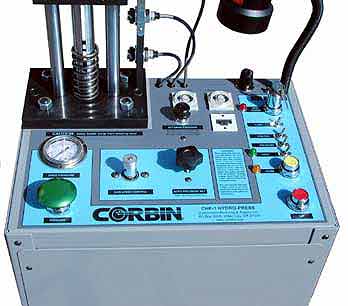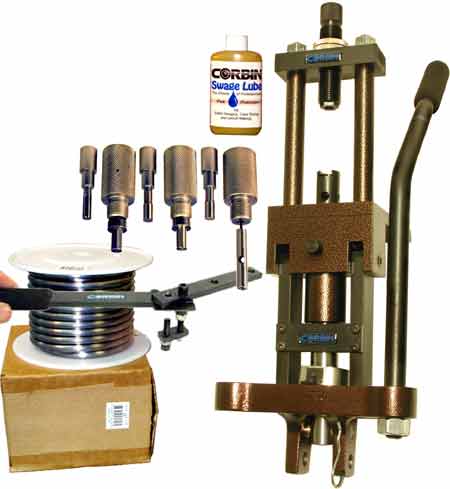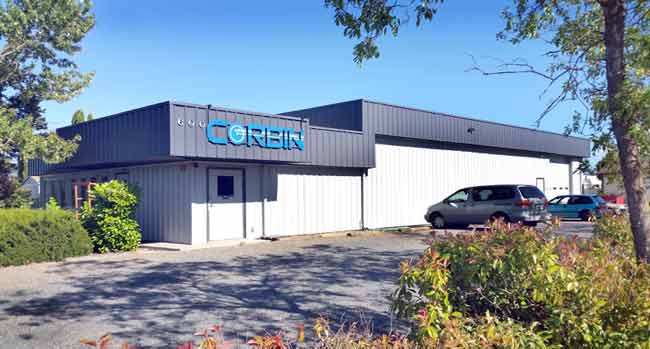
Make World-Class Bullets for Pennies! |

|

Make World-Class Bullets for Pennies! |

|
|
|
|
|


|
|
|
|

CORBIN Mfg , PO Box 2659, 600 Industrial Circle, White City, OR 97503 Phone: 541-826-5211 - - 9am-5pm Mon-Thurs - - FAX: 541-826-8669 (24/7) E-mail: sales@corbins.com - - Orders: www.SwageDies.com 
|
|
    |
    |
Note from Dave Corbin:
 The volume of calls I get every day makes it inevitable that many people will not be able to reach me in person without
a number of tries. I apologize in advance but I find that 99.9% of the questions are already answered better,
in more detail, here on this website, with photos and examples and prices. Usually, the question is this:
The volume of calls I get every day makes it inevitable that many people will not be able to reach me in person without
a number of tries. I apologize in advance but I find that 99.9% of the questions are already answered better,
in more detail, here on this website, with photos and examples and prices. Usually, the question is this:
How do I get started and how much does it cost? Of course, I can't answer that without knowing what you want to make. So I ask the same questions that are found right on this web site, in the little blue boxes. Then I provide the same answers you can read right here, depending on the caliber and specifics of your bullet design. Please note that, unlike reloading dies, the caliber doesn't affect the process, the tooling, or the prices except in broad ranges. The same kind of tools and procedures that work for a 9mm pistol bullet apply to a .308 rifle bullet, and the same procedures and kind of dies that make airgun pellets also make shotgun slugs, muzzle loader bullets, and lead pistol bullets. Look at the style and shape, rather than specific diameter, to determine what you need. Pin it down to caliber after you've figured out what makes the style and shape of bullet desired.
| ||||||||||
|
| ||||||||||
 The secure web store is the best place to enter your order. It gives you an instant email invoice summary with order number,
and NO CHARGES are made to your bank card automatically... I review each order first, so I can contact you if I don't think you
ordered things that work together or might have a lower cost suggestion to do the same thing.
You can use VISA or MasterCard, PayPal, wire transfer, or send a check. Or just use it as way to get a quote:
add thing you want to your cart to see the total. Bank card payment has a 4% processing fee added by the processor at check out. (Otherwise we would be forced to add 4% to the price to cover the cost).
The secure web store is the best place to enter your order. It gives you an instant email invoice summary with order number,
and NO CHARGES are made to your bank card automatically... I review each order first, so I can contact you if I don't think you
ordered things that work together or might have a lower cost suggestion to do the same thing.
You can use VISA or MasterCard, PayPal, wire transfer, or send a check. Or just use it as way to get a quote:
add thing you want to your cart to see the total. Bank card payment has a 4% processing fee added by the processor at check out. (Otherwise we would be forced to add 4% to the price to cover the cost).
I encourage you to use the web store because it is faster, very safe, and doesn't get "lost in the mail" or incorrectly heard over the phone (too many guns going off by my ears without hearing protection, during my days in the Navy, back in the 60's!). Also, the web store is there 24/7, takes no days off and doesn't step out to lunch... you can ALWAYS place an order there, which will be reviewed carefully before it is filled. | ||||||||||
|
| ||||||||||
|
In brief, any bullet from .120 to .458 diameter, that is 1.3 inches long or shorter, and is made of normal jacketed
or unjacketed lead or powdered metals, can be swaged using the -S type dies and the CSP-1 S-press.
Any bullet that is longer, made of harder materials, or larger in diameter, can usually be made with the CSP-2 Mega Mite press, or the CHP-1 Hydro Press, with -H type dies. Which set of dies? Depends on the bullet design. Click the blue label, above, appropriate to what you want to know. Most of the flat base lead or jacketed bullet designs use the FJFB-3-S 3-die set, or the FJFB-3-H 3-die set. Here's the easy way to get all your questions answered at your leisure, even if my phone is so tied up with callers that you can't get anything but the infuriating answering system... ... just select one of the above options, to answer your questions on how to make a bullet, what it costs, and what you need. You will find it above. It may take a little time because there are SO many options...I've been developing this equipment for people for over 45 years. There isn't a bullet you can imagine for which we have not made tools! Or if there is, we can probably do it anyway. If you want to find a specific item, use the SEARCH box. Type in a key word or phrase such as "reloading press", or "paper patch" or "50 BMG" or "Subsonic". That will bring up pages that talk about these matters, and you can usually locate what you want if you glance through the list. Don't feel you have to read everything. Just focus on the kind of bullet you want to make. That will eliminate 90% of the need to look at other pages. For an even quicker but less detailed view of equipment and prices, look at SwageDies.com, which is our on-line webstore. It is ideal for browsing. You don't have to buy anything to use it to accumulate a shopping cart with a total of things in it to get a quick "quote". | ||||||||||
|
| ||||||||||
|